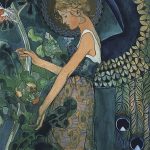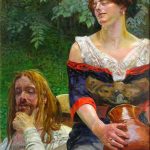Józef Chełmoński, a prominent Polish realist painter, was born on November 7, 1849, in Boczki, near Łowicz, Poland. Renowned for his depictions of rural life, landscapes, and animals, Chełmoński played a crucial role in the development of Polish art during the late 19th and early 20th centuries.
Chełmoński’s artistic talent became evident early in his life, leading him to enroll at the School of Fine Arts in Warsaw at the age of 14. His academic training continued in Munich and Paris, where he studied under the guidance of prominent artists, including Aleksander Wagner and Leon Bonnat. The exposure to diverse artistic influences contributed to the formation of Chełmoński’s unique style.
The artist’s early works focused on historical and genre scenes, reflecting the prevailing academic trends of the time. However, Chełmoński’s encounter with the rural landscapes of central Poland during a visit to his family’s estate marked a turning point in his artistic trajectory. The pastoral scenes and the lives of peasants became central themes in his work.
One of Chełmoński’s most famous paintings, “The Storks,” exemplifies his ability to capture the beauty of nature and the simplicity of rural life. His landscapes, often featuring idyllic countryside settings, conveyed a deep connection to the Polish rural environment. Paintings like “Reapers” and “Burning the Stubble” showcased his keen observation and genuine affection for the daily lives of peasants.
Chełmoński’s fascination with animals, particularly horses, manifested in a series of paintings that captured the vitality and spirit of these creatures. His equestrian scenes, such as “The Horseshoeing,” depicted the dynamic relationship between humans and horses, emphasizing the artist’s ability to convey movement and energy.
The artist’s success extended beyond Poland, as he participated in international exhibitions and received acclaim from art critics and collectors. Chełmoński’s works were characterized by a naturalistic approach, a warm color palette, and a sincere depiction of his subjects.
Despite his success, Chełmoński faced personal challenges, including financial difficulties and health issues. His later years were marked by a return to Warsaw, where he continued to paint and exhibit his works. The artist’s commitment to realism and his ability to evoke an emotional connection to his subjects contributed to his lasting impact on Polish art.
Józef Chełmoński passed away on April 6, 1914, in Kuklówka, near Warsaw. His legacy endures through the influence he had on subsequent generations of Polish artists. Chełmoński’s dedication to portraying the beauty of the Polish countryside and the lives of its inhabitants left an indelible mark on the country’s artistic heritage. Today, his paintings are celebrated for their authenticity, capturing a poignant and timeless vision of rural life in Poland.






